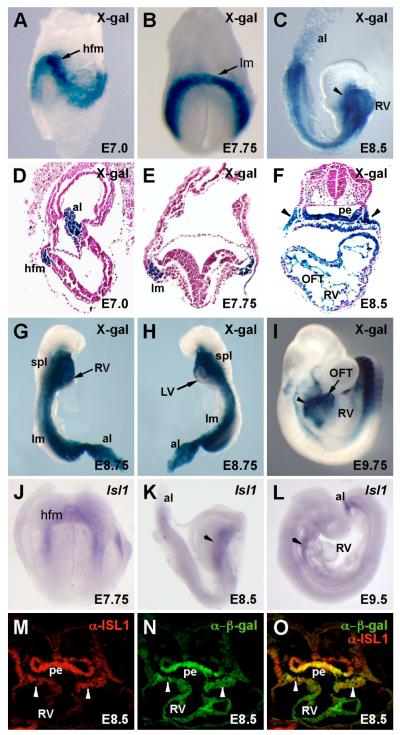Fig. 2.
The Isl1-F-lacZ transgene is expressed broadly in the mesoderm and in the SHF during early mouse embryonic development. Representative whole-mount (A-C, G-I) and sagittal (D) or transverse (E, F) sections of X-gal-stained Isl1-F-lacZ transgenic embryos are shown. (A, D) Isl1-F directed strong lacZ expression to the mesoderm at E7.0, including heart-forming anterior lateral mesoderm (hfm) and in the extraembryonic mesoderm in the allantois (al). (B, E) Isl1-F activity became more robust and more refined to the lateral mesoderm (lm) at E7.75. (C, F) At E8.5, expression of Isl1-F-lacZ was evident in the SHF and its derivates in the pharyngeal mesoderm (arrowheads), pharyngeal endoderm (pe), outflow tract (OFT), and right ventricle (RV). (G, H) β-galactosidase activity was restricted to the RV and was largely absent from the left ventricle (LV) at E8.75. spl, splanchnic mesoderm. (I) At E9.75, β-galactosidase activity from the Isl1-F-lacZ transgene expression remained strong in the pharyngeal mesoderm (arrowhead) and was still visible in the OFT at this stage. (J-L) For comparison, whole mount in situ hybridization with an Isl1 antisense probe was performed at E7.75 (J), E8.5 (K), and E9.5 (L). Arrowheads mark the pharyngeal mesoderm in K and L. (M-O) Immunofluorescence analyses on transverse sections of Isl1-F-lacZ transgenic embryos at E8.5 using anti-Isl1 and anti-β-galactosidase antibodies shows that endogenous Isl1 protein (red) colocalizes with β-galactosidase (green) in SHF-derived tissues, including the pharyngeal mesoderm (arrowheads) and pharyngeal endoderm (pe).

